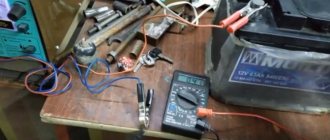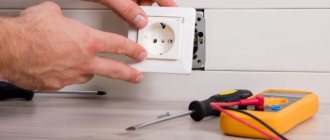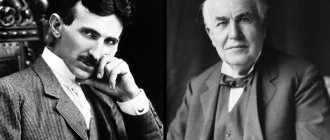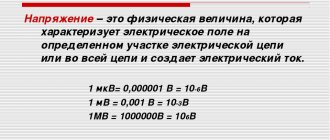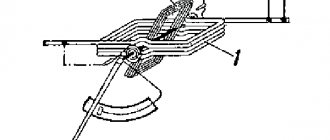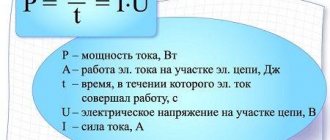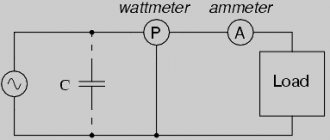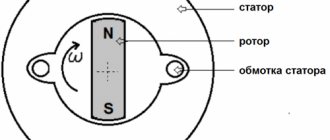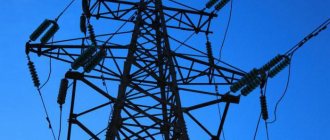Definition and formula of current
Definition
Electric shock
called the ordered movement of charge carriers. In metals, these are electrons, negatively charged particles with a charge equal to the elementary charge. The direction of current is considered to be the direction of movement of positively charged particles.
The current strength (current) through a certain surface S is a scalar physical quantity, which is denoted by I, equal to:
$$I=\frac{dq}{dt}$ (1)$
where q is the charge passing through the surface S, t is the charge travel time. Expression (1) determines the magnitude of the current at time t (instantaneous value of the current).
Ohm's law for a circuit section
The current strength in a section of the circuit is directly proportional to the voltage at the ends of this section and inversely proportional to its resistance:
Illustration of Ohm's law.
The current strength is directed towards the movement of charged particles (electrons). The strength of the current is opposed by resistance: the greater it is, the less the current strength (the fewer electrons pass through the conductor per unit time). But the increase in current strength is facilitated by voltage, which seems to push charged particles, causing them to move in an orderly manner.
Ohm's law for a section of a circuit, taking into account the formula for calculating resistance:
To compare and calculate resistance, the current-voltage characteristic is often used. This is the name given to the graphical representation of the dependence of current on voltage. Example of current-voltage characteristic:
The steeper the graph, the lower the conductor resistance. When calculating resistance, it is important to take into account the units of measurement of the quantities indicated on the axes.
Example No. 4. The figure shows a graph of current versus voltage on one section of the TV. What is the resistance of this section:
The point on the graph corresponding to 5 kV corresponds to a current strength of 20 mA.
First, let's convert the units of measurement to SI:
R = UI. . = 5000 0.02. . = 250000 (Ohm) = 250 (k Ohm)
When determining the resistance of the resistor, the student measured the voltage across it: U = (4.6 ± 0.2) V. The current through the resistor was measured so accurately that the error can be neglected: I = 0.500 A. Based on the results of these measurements, we can conclude that The resistance of the resistor is most likely
Source
Some types of current
The current is called constant if its strength and direction do not change over time, then:
$$I=\frac{q}{t}(2)$$
Formula (2) shows that the direct current is equal to the charge that passes through the surface S per unit time.
If the current is alternating, then instantaneous current strength (1), amplitude current strength and effective current strength are distinguished. The effective value of alternating current (Ieff) is the strength of direct current that will perform work equal to the work of alternating current during one period (T):
$$I_{eff}=\sqrt{\frac{1}{T} \int_{0}^{T} I^{2} dt}(3)$$
If alternating current can be represented as sinusoidal:
$$I=I_{m} \sin \omega t$$
then Im is the amplitude of the current ($\omega$ is the frequency of the alternating current).
The difference between voltage and current
Electricity, like any other matter, has its own characteristics that are used to determine the efficiency of operation and control specified parameters. In physics, there are such concepts as “voltage” and “current strength”. They describe the same phenomenon, but as indicators themselves they differ from each other.
Such differences lie in the principle of operation of electricity. Current strength is understood as the volume of electron flow that can travel a distance of one meter in a specified time interval. Voltage, on the contrary, is expressed in the amount of potential energy. Both concepts are closely related. External factors influencing them include:
- the material from which the conductor is made;
- temperature;
- a magnetic field;
- environmental conditions.
Differences also lie in the methods of obtaining these parameters. When charges on a conductor are exposed to an external magnetic field, a voltage is generated that generates flux between points in the circuit. Experts also highlight differences in energy consumption, called power. If voltage characterizes the parameters of potential energy, then current characterizes the parameters of kinetic energy.
Current Density
The distribution of electric current over the cross section of a conductor is characterized using the current density vector ($\bar{j}$). Wherein:
$$j_{n}=j \cos \alpha=\frac{d I}{d S}(5)$$
where $\alpha$ is the angle between vectors $\bar{j}$ and $\bar{n}$ ( $\bar{n}$ is the normal to the surface element dS), jn is the projection of the current density vector onto the direction of the normal ( $\bar{n}$).
The current strength in the conductor is determined using the formula:
$$I=\int_{S} jd S(6)$$
where integration in expression (6) is carried out over the entire cross section of the conductor S ($\alpha \equiv 0$)
For direct current we have:
$I = jS (7)$
If we consider two conductors with cross sections S1 and S2 and direct currents, then the following relation holds:
$$\frac{j_{1}}{j_{2}}=\frac{S_{2}}{S_{1}}(8)$$
Direction of electric current in metals
Negatively charged electrons move along metal wires, i.e. current flows from “–” to “+” source. The direction of electron motion is called real. But historically in science, the conditional direction of current is accepted from “+” source to “–”.
Actions of electric current (energy conversion)
Electric current can cause various actions:
- Thermal - electrical energy is converted into heat. This transformation is provided by an electric stove, electric fireplace, and iron.
- Chemical - electrolytes undergo electrolysis under the influence of direct electric current. During electrolysis, negative ions (anions) are attracted to the positive electrode (anode), and positive ions (cations) are attracted to the negative electrode (cathode).
- Magnetic (electromagnetic) - in the presence of an electric current in any conductor, a magnetic field is observed around it, i.e. a conductor carrying current acquires magnetic properties.
- Luminous - electric current heats metals to white heat, and they begin to glow like a tungsten spiral inside an incandescent lamp. Another example is LEDs, in which light comes from the emission of photons as an electron moves from one energy level to another.
- Mechanical - parallel conductors with electric currents flowing in one direction attract, and in opposite directions they repel.
Current formula. How to find current. We calculate and determine the current using the formula of Ohm's law.
The fundamental formula for finding current is the classic Ohm's law, which states that current is equal to voltage divided by resistance. And this is the fundamental formula of any electrician and electronics engineer, which is constantly used to quickly calculate the current strength of a particular circuit. Of any two known quantities of Ohm's law (current, voltage and resistance), you can always find the third. In the case of finding the voltage, we multiply the current by the resistance, but when calculating the current or resistance, we always divide the voltage by the value that is known (current strength or resistance).
It is worth saying that this current formula is suitable for both alternating and direct current. Although there are some nuances for the variable. Namely: these are cases when we use active loads (heaters, light bulbs). The current formula shows the relationship between voltage, resistance, and current strength itself.
Since an important characteristic used in the field of electricity is also electrical power, it can also be used to find the current strength. Electrical power is the product of current and voltage. And to find the current, you need to divide the power by a known voltage. For example, we know the power of the heating element, which is 880 W. We also know the voltage that will be supplied to it, equal to 220 V. We need to find the current strength that will flow through the power circuit of this heater. To do this, we simply divide 880 watts by 220 volts, which will give a current of 4 amperes.
Now how can you calculate this current using the current formula (according to Ohm’s law) knowing the voltage and resistance. So, we still have the same voltage of 220 volts, and we have the same heating element. We use a multimeter or tester to measure the resistance of the element (for a heater with a power of 880 watts and designed for a voltage of 220 volts, it will be 55 ohms). And to find the current strength, we divide the voltage of 220 volts by the heater resistance of 55 ohms, as a result we get the same current strength of 4 amperes.
You just need to remember these two formulas for current well (finding it through power and through resistance with a known voltage). Then you can quickly and easily calculate in your head both the current strength of an electrical circuit and any other electrical quantities (voltage, resistance, power).
Well, if you are more of a practitioner, then just pick up meters and measure. Let me remind you that we measure voltage by parallelly applying the probes of a tester or multimeter to the contacts on which the magnitude of the potential difference will be measured. We measure the current strength by breaking the circuit where the current strength needs to be measured, that is, we break the electrical circuit at the beginning (closer to the power source) and between this break we connect the probes of our current meter (ammeter). Do not forget that the alternating current must correspond to its position on the tester switch, and the direct current to its place (otherwise you will get incorrect measured current values).
PS To better remember Ohm's law, you just keep in mind that when dividing, the voltage is always at the top, that is, if according to Ohm's law we find the voltage, then we multiply the current by the resistance, well, in the other two cases (when finding resistance or current) we always We divide the voltage by a known value, obtaining a second value that was previously unknown.
Current sources
An electric current source is an electrical device that converts a certain type of energy into electrical energy. Such devices are divided into physical and chemical.
The operating principle of chemical sources is based on the conversion of chemical energy into electrical energy. This transformation occurs independently and does not require outside participation. Depending on the renewability of elements and the type of reactions, they are divided into:
- Primary (batteries) Primary sources cannot be used a second time if they are discharged, since the chemical reactions occurring in them are irreversible. They are divided into fuel and semi-fuel cells. Fuel batteries are similar to batteries, but the chemicals in them are charged separately, and they come out as products of a chemical reaction. This helps them work for a long time. Semi-fuel includes one of the chemical elements, and the second is gradually added throughout use. Their service life is determined by the supply of non-renewable substance. If regeneration through charging is possible for such an element, then it resumes its capabilities as a battery.
Batteries - as primary chemical sources of current
- Secondary (batteries) undergo a charging cycle before use. The charge they receive during the process can be transported along with the devices. After the charge is consumed, it can be regenerated due to charging and the reversibility of the chemical reaction. Also classified as secondary are renewable elements that are mechanically or chemically charged and restore their ability to power devices. They are designed in such a way that after a certain period of time they require replacement of certain parts in order for the reaction to continue.
Types of electric power sources
Important! It should be understood that the division into batteries and accumulators is conditional. The properties of the battery can be manifested, for example, in alkaline batteries, which can be revived at a certain state of charge.
You might be interested in this: Features of the electrician profession
Also, according to the type of reagents, chemical sources are divided into:
- Acidic.
- Saline.
- Alkaline.
Physical sources of electric current are based on the conversion of mechanical, as well as nuclear, thermal or light energy into electrical energy.
Industrial three-phase current generator
Nature of origin
Electric current is the directed movement of charged particles under the influence of an electric field.
The particles are:
- in metal conductors - electrons;
- in semiconductors - holes or electrons;
- in a vacuum - electrons (under certain conditions);
- in gases - electrons and ions;
- in solutions and melts of electrolytes - ions.
Until electric current flows through the conductor, the particles move chaotically . And their number flowing in one direction approximately corresponds to the number of particles flowing in the opposite direction.
But the situation changes after current is passed through the conductor. In this case, the number of particles moving in one direction increases significantly. And the more of them pass through the cross-section of the conductor per unit time, the greater the current strength.
